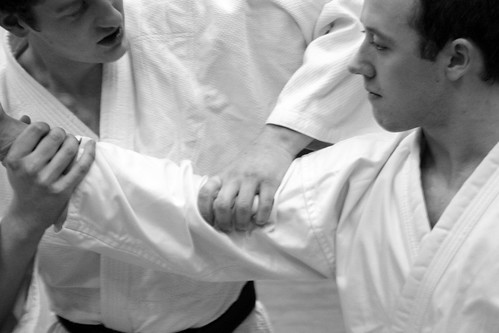A practice that we have recently begun integrating into our kids classes (and it wouldn't hurt the adults either) comes from Grossman & Christensen's On Combat: The book talks about how your heart rate is sort of an indicator of stress level, and how as your heart rate gets close to peaking out, you lose find and complex motor skills and experience all sorts of interesting perceptual phenomena, such as tunnel vision, auditory exclusion, and time dilation. I'd heard most of this before, though not this thoroughly presented, but they took it a step further and gave an example of the importance of these phenomena - dialing 911 while under extreme stress.
.
Think about it. It is a fine motor skill that requires tactile and visual feedback - all things that are degraded when under acute stress, and it is a skill that you probably haven't ever practiced (how many times have you dialed 911 in your life?)
.
So, the practice, suggested by Grossman & Christensen, is to place the students under some stress (breakfalls or kata or burpees or something) and have them intersperse bouts of that stress with repeatedly dialing 911 on an un-plugged phone. We added to this a short lecture about when you should dial 911 (whenever something really bad happens and there is noone around to help you) and we not only make them dial, but state their name and their emergency.
.
Grossman & Christensen's book, On Combat, is not only chock full of great info on psychophysiology of extreme stress, but great exercises and suggestions like this. Things that make you slap your forehead and think, "Why didn't I think of that?" Highly recommended reading. If you're interested, please consider purchasing the book from my Amazon link below - they'll throw me a little kickback if you do.
.
Think about it. It is a fine motor skill that requires tactile and visual feedback - all things that are degraded when under acute stress, and it is a skill that you probably haven't ever practiced (how many times have you dialed 911 in your life?)
.
So, the practice, suggested by Grossman & Christensen, is to place the students under some stress (breakfalls or kata or burpees or something) and have them intersperse bouts of that stress with repeatedly dialing 911 on an un-plugged phone. We added to this a short lecture about when you should dial 911 (whenever something really bad happens and there is noone around to help you) and we not only make them dial, but state their name and their emergency.
.
Grossman & Christensen's book, On Combat, is not only chock full of great info on psychophysiology of extreme stress, but great exercises and suggestions like this. Things that make you slap your forehead and think, "Why didn't I think of that?" Highly recommended reading. If you're interested, please consider purchasing the book from my Amazon link below - they'll throw me a little kickback if you do.
.
____________
Patrick Parker, is a Christian, husband, father, judo and aikido teacher, Program Director for a Cardiac Rehab, and a Ph.D. Contact: mokurendojo@gmail.com or phone 601.248.7282
____________
Subscribe now for free updates from the Mokuren Dojo blog
Patrick Parker, is a Christian, husband, father, judo and aikido teacher, Program Director for a Cardiac Rehab, and a Ph.D. Contact: mokurendojo@gmail.com or phone 601.248.7282
____________
Subscribe now for free updates from the Mokuren Dojo blog


